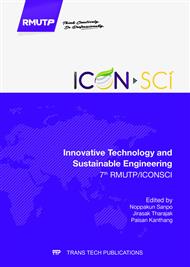p.295
p.301
p.305
p.309
p.313
p.318
p.322
p.329
p.333
Electrical Sheet Resistance and Wetting Properties of TiO2 Nanoparticle Thin Films Prepared by Sparking Process
Abstract:
An electrical sheet resistance and water contact angle of titanium dioxide nanoparticle thin films were prepared by sparking process. The experiments were carried out by the titanium wires as electrodes of sparking process and varied the sparking time of 1-4 h and the annealing temperature of 200-400 OC for 2 h. The as-deposited and as-annealed of thin films on glass substrate were measured a water contact angle and a sheet resistance whereas a surface was analyzed by a scanning electron microscopy. The results found that the optimum as-deposited TiO2 NP thin films was shown the homogeneity surface, the minimum sheet resistance and the duplicate water contact at the sparking time of 3 h. The optimum as-deposited TiO2 NP thin films was annealed which the water contact angle and the sheet resistance of the as-annealed TiO2 NP thin films decreased with increasing the annealing temperature. However, the hydrophilic property was shown optimum at the annealing temperature of 400 OC.
Info:
Periodical:
Pages:
313-317
Citation:
Online since:
June 2017
Authors:
Price:
Сopyright:
© 2017 Trans Tech Publications Ltd. All Rights Reserved
Share:
Citation:


